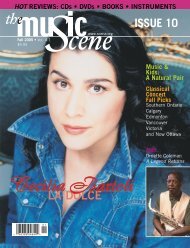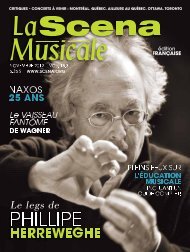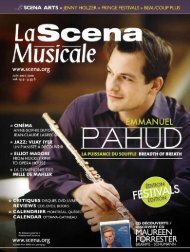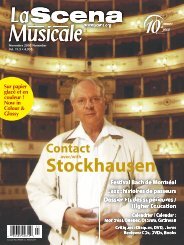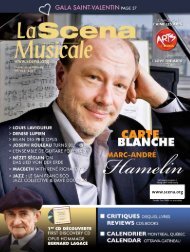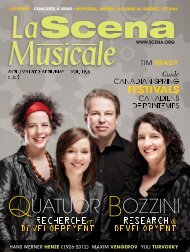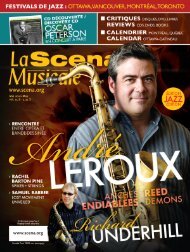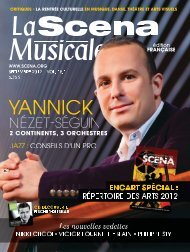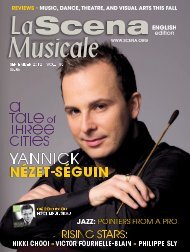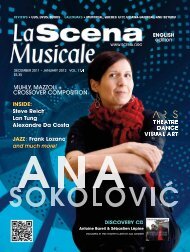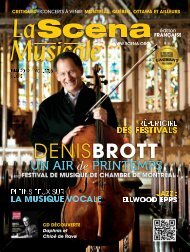Create successful ePaper yourself
Turn your PDF publications into a flip-book with our unique Google optimized e-Paper software.
ARIA of the MONTH<br />
ALINE KUTAN<br />
QUEEN OF THE NIGHT<br />
Wah Keung Chan<br />
OPERA DE MASSY, FRANCE.<br />
The most recognizable aria from<br />
Mozart’s popular opera The Magic<br />
Flute is the Queen of the Night’s second<br />
aria “Der Hölle Rache.” The first<br />
half culminates in the memorable<br />
passages of two successive sequences of eight<br />
staccato high notes before the soprano launches<br />
into an arpeggio peaking at two high Fs. Such highflying<br />
singing requires the agility of a coloratura<br />
soprano. However, no light-voice singer need apply<br />
lest the aria should come across as a lullaby; the<br />
role belongs to a true dramatic coloratura voice<br />
capable of evoking the evil in the text.<br />
CHARACTER<br />
“The Queen of the Night portrays the dark side of<br />
human emotion,” says Canadian soprano Aline<br />
Kutan, who has sung the role in over 20 productions.“She<br />
is the antagonist in this fairy tale, : and<br />
she is as manipulative as she is vain. I don’t think<br />
she realizes herself that she’s such an evil person.”<br />
Kutan feels the Queen is a desperate<br />
woman, who tries to get back the power her husband<br />
gave to Sarastro at his deathbed, and gradually<br />
sinks to evil. Her manipulation of Tamino in<br />
the First Act does not pay off, so she desperately<br />
blackmails her daughter to kill Sarastro. “I think<br />
that she truly shows her evil ways in the second<br />
aria when, instead of protecting her daughter,<br />
she gives her the knife instead and says ‘here, kill<br />
my enemy or else you will nevermore be my<br />
daughter’” Kutan explains.<br />
THE ARIA<br />
The way the aria has been sung has changed<br />
through the years, “You’ll find in the 1930s, it is<br />
sung in Bel Canto style,” says Kutan. You get a<br />
more lyrical, unattached way of going from one<br />
note to another that creates a smoother and<br />
uninterrupted line. It creates a cleaner sound, in a<br />
way. What you’ll find today with singers like<br />
Natalie Dessay and Diana Damrau is more fire<br />
and bite in the sound—so that there’s more of a<br />
Baroque style. In the whole opera Sarastro sings<br />
very classical lines. But the Queen of the Night is<br />
written very much in baroque style—especially<br />
the second aria. I think Mozart wanted that kind<br />
of feeling to the character.”<br />
Kutan demonstrates, spitting out the words, giving<br />
more emphasis to the text, and points out,“For<br />
me drama actually happens through how you<br />
would do it in theatre. For example, when I’m<br />
teaching students how to sing the Queen of the<br />
Night, I’d say ‘Don’t give more volume and don’t<br />
give more sound.’ Many people think you have to<br />
give more sound in order to get the dramatics, but<br />
actually in theatre or in real life—you would spit<br />
out your words because you’re really angry and you<br />
want to emphasize every word. In the old days, they<br />
didn’t do that as much. They wanted to sing beautiful<br />
lines and it came off sounding too light and<br />
bird like. But I don’t think Mozart intended that<br />
because the words that are sung are vengeance,<br />
death and destruction and these lines need to be<br />
delivered with as much gusto and bite as possible.<br />
It has to sound terrifying.”<br />
THE SCORE<br />
Technically speaking, the challenge for the soprano<br />
is singing a clean coloratura and hitting the<br />
high Fs. For Kutan, it’s more than those four top<br />
notes: “Everyone says, ‘Oh my gosh, she got those<br />
high Fs or she didn’t.’ For me, it’s the whole<br />
encompassing of the role that you need to get.” In<br />
the middle part, on the text “Alle Bande”, Mozart<br />
changes the previous staccato coloratura passages<br />
to a legato coloratura. She adds, “It’s sung<br />
legato but Mozart never actually wrote legato in<br />
the original score. He never even wrote staccatos<br />
when they are sung. Those triplets are like a serpent<br />
and these lines moving up and down wind<br />
around like a snake hypnotizing its prey. The subsequent<br />
staccato passage mimics her laughter—<br />
at that point, a manic laughter, like a wicked<br />
witch.” Kutan cites the Disney films: the wicked<br />
stepmother in Snow White and Cinderella.<br />
The physical stamina required for this aria<br />
makes it like a sporting challenge. “Already in the<br />
first two pages you’ve sung your High Fs,” says<br />
Kutan. “And by the 3 rd and 4 th pages you’ve got to<br />
still keep going with stamina. So it can be very tiring<br />
by the 4 th page, especially if the dress is really<br />
heavy, and I’ve worn a few of those. I actually prefer<br />
running around the stage because it gives me<br />
the motivation to give that knife to Pamina—the<br />
bodily motivation actually gives the motivation to<br />
sing these lines.”<br />
Since taking on the role at a student production<br />
at <strong>La</strong>val University in 1991, Kutan has sung it<br />
at Opéra National de Paris, Glyndebourne,<br />
Santiago, Chile, Opéra de Toulouse, New York City<br />
Opera and l’Opéra de Québec, in 2003. “I can sing<br />
it with more body and a little more bite, be more<br />
dramatic without pushing,” she asserts. On<br />
YouTube, a grainy video from her 2007 performance<br />
in Santiago shows Kutan in this convincing<br />
form.(www.youtube.com/watch?v=2wrjfkz01uY)<br />
Since Kutan developed the high Fs only around<br />
age 20, she believes that high notes can be mastered<br />
through training.However,she cautions about<br />
taking on this aria too early, “When I auditioned<br />
with this aria for Ileana Cotrubas at age 23, she told<br />
me ‘Be careful not to sing this all the time because<br />
you can damage your voice.’ I didn’t take it on until I<br />
was 28. So don’t try this at home unless you are<br />
supervised, you might damage your vocal cords.” ■<br />
Aline Kutan sings the Queen of the Night in Mozart’s The<br />
Magic Flute, along with Karina Gauvin as Pamina with<br />
Montreal Opera, Nov. 7, 11, 14, 16, 19, 21, operademontreal.com.<br />
<strong>La</strong> <strong>Scena</strong> <strong>Musicale</strong> is organizing a group on<br />
Nov. 19 as a fundraiser. 514-656-3947, sub@scena.org.<br />
OPERA DE MONTE CARLO.<br />
KUTAN’S FAVOURITE<br />
QUEENS OF THE NIGHT:<br />
Edita Guberova, Roberta Peters, Natalie<br />
Dessay, Edda Moser and Lucia Popp.<br />
26 Novembre 2009 November



